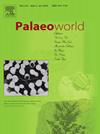Actinopterygians from the continental Permian–Triassic boundary section at Babiy Kamen (Kuznetsk Basin, Siberia, Russia)
IF 1.7
3区 地球科学
Q2 PALEONTOLOGY
引用次数: 0
Abstract
The Kuznetsk Basin in Siberia (Russia) is an important area for the study of the continental biota of late Permian to Early Triassic in continuous sections. This study presents a taxonomic description of ray-finned fishes (other fish remains are absent at the section) from the Permian–Triassic boundary section at Babiy Kamen. The new material was collected, bed by bed, during geological and paleontological excavations of coastal-floodplain, shallow-basin deposits of the Tailugan and Maltseva formations. The poorly preserved but diverse ichthyofaunal fossils of the Tailugan Formation consists predominantly of typical Late Paleozoic “palaeoniscoid” fishes (Eurynotoidiidae, Varialepididae, etc.). The earliest known Triassic (Induan) Kedrovo Member of the Maltseva Formation contained a less diverse but well preserved ichthyofaunal fossils including “palaeoniscoid” fishes (Korutichthys and Avamia). The same species were described earlier from the Induan of the Tunguska Basin. The ichthyofauna of the Early Triassic (Olenekian) Ryaboy Kamen Member of the Maltseva Formation consists of typical Triassic stem-neopterygian (Evenkia, Eoperleidus and Arctosomus) fishes. The same fishes have been described earlier from the Olenekian of Tunguska Basin. The composition of the ichthyofauna completely changed twice — at the Permian–Triassic and the Induan–Olenekian boundaries.
来自巴比卡门(俄罗斯西伯利亚库兹涅茨克盆地)大陆二叠纪-三叠纪边界剖面的动口纲动物
俄罗斯西伯利亚库兹涅茨克盆地是研究二叠纪晚期至三叠纪早期大陆生物群连续剖面的重要地区。本研究介绍了巴比卡门二叠纪-三叠纪边界剖面中鳐鱼类(该剖面没有其他鱼类遗骸)的分类学描述。新材料是在对泰卢根地层和马尔采娃地层的沿海洪积平原浅盆地沉积物进行地质和古生物发掘时逐层采集的。泰卢根地层的鱼类化石保存较差,但种类繁多,主要由典型的晚古生代 "古类 "鱼类(Eurynotoidiidae、Varialepididae 等)组成。马尔采瓦地层中已知最早的三叠纪(印支期)Kedrovo 成员包含种类较少但保存完好的鱼类化石,其中包括 "古类 "鱼类(和)。早些时候,通古斯卡盆地的印端也曾描述过相同的物种。马尔采瓦地层早三叠世(奥利尼克期)Ryaboy Kamen 组的鱼类化石包括典型的三叠世茎新目鱼类(、和)。早先在通古斯卡盆地的奥连纪中也曾描述过同样的鱼类。鱼类动物群的组成在二叠纪-三叠纪和印支-奥勒涅基纪的交界处发生了两次彻底的变化。
本文章由计算机程序翻译,如有差异,请以英文原文为准。
求助全文
约1分钟内获得全文
求助全文
来源期刊

Palaeoworld
PALEONTOLOGY-
CiteScore
4.00
自引率
5.90%
发文量
95
期刊介绍:
Palaeoworld is a peer-reviewed quarterly journal dedicated to the study of past life and its environment. We encourage submission of original manuscripts on all aspects of palaeontology and stratigraphy, comparisons of regional and global data in time and space, and results generated by interdisciplinary investigations in related fields. Some issues will be devoted entirely to a special theme whereas others will be composed of contributed articles. Palaeoworld is dedicated to serving a broad spectrum of geoscientists and palaeobiologists as well as serving as a resource for students in fields as diverse as palaeobiology, evolutionary biology, taxonomy and phylogeny, geobiology, historical geology, and palaeoenvironment.
Palaeoworld publishes original articles in the following areas:
•Phylogeny and taxonomic studies of all fossil groups
•Biostratigraphy, chemostratigraphy, chronostratigraphy
•Palaeoecology, palaeoenvironment and global changes throughout Earth history
•Tempo and mode of biological evolution
•Biological events in Earth history (e.g., extinctions, radiations)
•Ecosystem evolution
•Geobiology and molecular palaeobiology
•Palaeontological and stratigraphic methods
•Interdisciplinary studies focusing on fossils and strata
 求助内容:
求助内容: 应助结果提醒方式:
应助结果提醒方式:


